Everyday Mathematics 2nd Grade Answer Key Unit 5 Addition and Subtraction
Everyday Math Grade 2 Home Link 5.1 Answer Key
Solving Addition Facts
Family Note
Today we continued working with additional facts. Children can develop number-fact reflexes the same way that they develop any other habit—by practicing them over and over. In Everyday Mathematics knowing facts automatically is called fact power. We discussed ways to develop fact power, such as practicing with Fact Triangles and playing fact games.
When your child has solved the addition facts below and is ready to draw the mouse’s path through
the maze, explain that the mouse can move up, down, left, right, or diagonally to find the cheese.
Please return this Home Link to school tomorrow.
Solve the facts. Then draw a path for the mouse to find the cheese. The mouse can go through only those boxes with a sum of 7
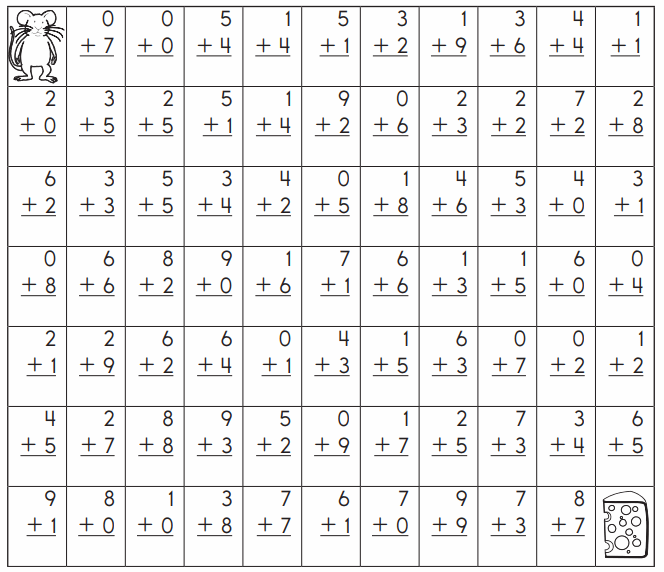
Answer :
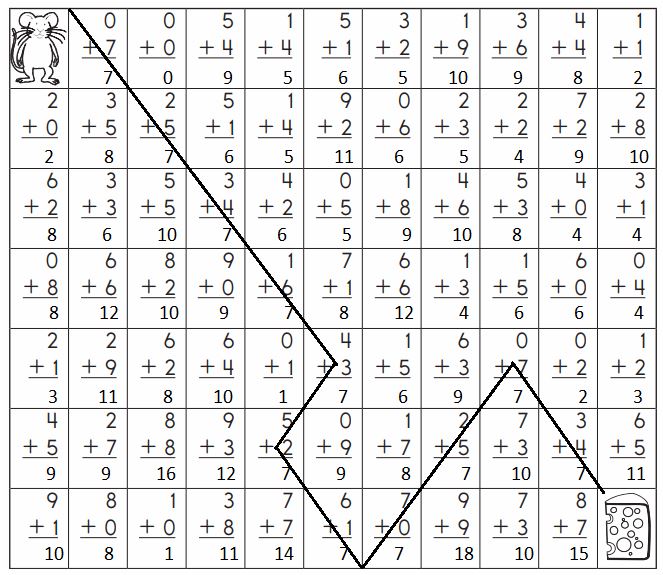
Everyday Math Grade 2 Home Link 5.2 Answer Key
Paying for Items
Family Note
In class today we reviewed coin equivalencies and found different coin combinations to represent the same amount of money. For example, 12¢ can be shown with 12 pennies, with 2 nickels and 2 pennies, 1 nickel, and 7 pennies, or 1 dime and 2 pennies. In this activity, your child looks through advertisements, selects items that cost less than $2, and shows how to pay for those items by drawing coins and bills. If you do not have access to advertisements, make up some items and prices.
Please return this Home Link to school tomorrow.
Look at newspaper or magazine ads. Find three items that cost less than $2. Write the name and the price of each item. Show someone at home how you could pay for these items with coins and a $1 bill. Write ℡, ℣, ℤ, ℥, and ℘.
Question 1.
I would buy __. It costs ___. This is how I would pay:
Answer:
I would like to buy a book.
It Costs 21 ¢
21 ¢ Can be shown as
2 dime 1 penny
1 dime = 10 cents
So 2 dimes = 2 x 10 = 20 cents
1 penny = 1 cent
Total : 20 + 1 = 21 ¢
Question 2.
I would buy __. It costs __. This is how I would pay:
Answer:
I would like to buy a toy car.
It costs $1 30 ¢
$1 30¢ can be shown as
$1 bill + 1 quarter + 1 Nickel
Total = $1 + 25 + 5 = $1 30 cents.
Question 3.
I would buy __. It costs ___. This is how I would pay:
Answer:
I would like to buy A Drawing book
It Costs 75 ¢
75¢ Can be shown As
3 quarters
We know that,
1 quarter = 25 cents
So, 3 quarters = 3 x 25
Total : 75¢
Practice
Fill in the unit box. Solve.
Question 4.
17 – 8 = __
Answer:
9
Question 5.
6 + ___ = 13
Answer:
7
Question 6.
__ – 4 = 9
Answer:
13
Question 7.
9 + 7 = __
Answer:
16
Everyday Math Grade 2 Home Link 5.3 Answer Key
Change at a Garage Sale
Family Note
Today your child practiced making change by counting up. For example: Suppose an apple costs 17¢ and is paid for with a quarter (or 25¢). One way to make change by counting up is to put down three pennies as you say “18, 19, 20” and then put down a nickel and say “25 cents,” making 8¢ in change. In today’s Home Link activity your child “sells” small items from around your home at a mock garage
sale. Using real coins will make this activity easier. If you feel your child is ready, you can increase the cost of some items and use combinations of coins to pay for them.
Please return the second page of this Home Link to school tomorrow.
Pretend you are having a garage sale. Do the following:
- Find small items in your home to “sell.”
- Give each item a different price. Every price should be less than 25¢.
- Pretend that customers pay for each item with a quarter.
- Show someone at home how you would make change by counting up. Use
 to draw the change.
to draw the change.
Example:
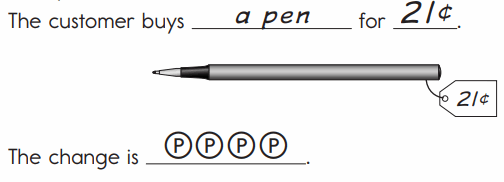
Question 1.
The customer buys ___ for ___. The change is __.
Answer:
The customer buys a ball for 24¢.
The change is 1¢
Question 2.
The customer buys ___ for __. The change is ___.
Answer:
The customer buys a Chocolate for 10¢.
The change is 15¢
Question 3.
The customer buys __ for __. The change is ___.
Answer:
The customer buys a Pencil for 10¢.
The change is 15¢
Question 4.
The customer buys ___ for ___. The change is __.
Answer:
The customer buys a Scale for 15¢.
The change is 10¢
Practice
Fill in the unit box. Solve.
Question 5.
11 – __ = 8
Answer:
3
Question 6.
8 + __ = 15
Answer:
7
Question 7.
__ + 7 = 14
Answer:
7
Question 8.
13 – 8 = __
Answer:
5
Everyday Math Grade 2 Home Link 5.4 Answer Key
Counting Up to Make Change
Family Note
Help your child identify the change he or she would receive by counting up from the price of the item to the amount of money used to pay for it. Use real coins and bills to act out the problems with your child. You will need a $1 bill and at least 3 quarters, 5 dimes, 5 nickels, and 5 pennies.
Please return this Home Link to school tomorrow.
Complete the table.
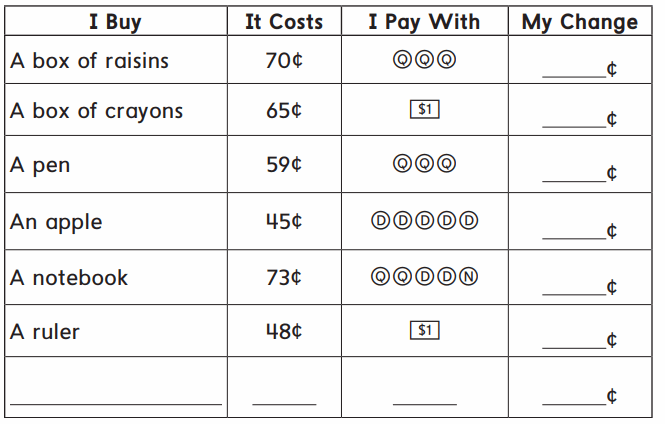
Answer :
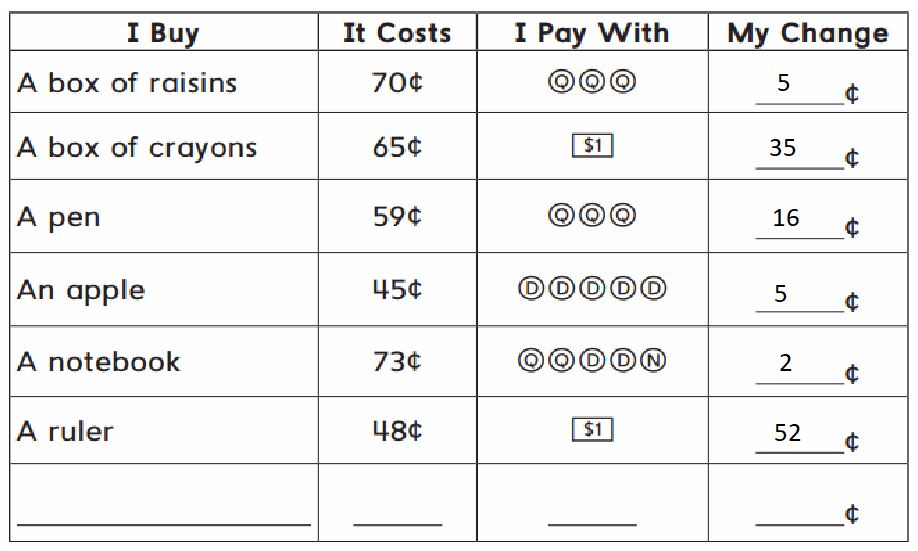
Practice
Solve.
Question 1.
12 – __= 9
Answer:
3
Question 2.
9 + __ = 16
Answer:
7
Question 3.
__ + 8 = 11
Answer:
3
Question 4.
14 – 8 = __
Answer:
6
Everyday Math Grade 2 Home Link 5.5 Answer Key
Clock Faces and Digital Notation
Family Note
Today your child played Clock Concentration, a game that involves matching clock faces to times in digital notation (such as 6:00 or 12:30). By the end of Grade 2, your child is expected to tell time to the nearest 5 minutes. By the end of Grade 3, your child will be expected to tell time to the nearest minute.
Please return this Home Link to school tomorrow.
Draw a line matching each clock face to a time.
Question 1.

Question 2.

Question 3.

Question 4.

Answer:
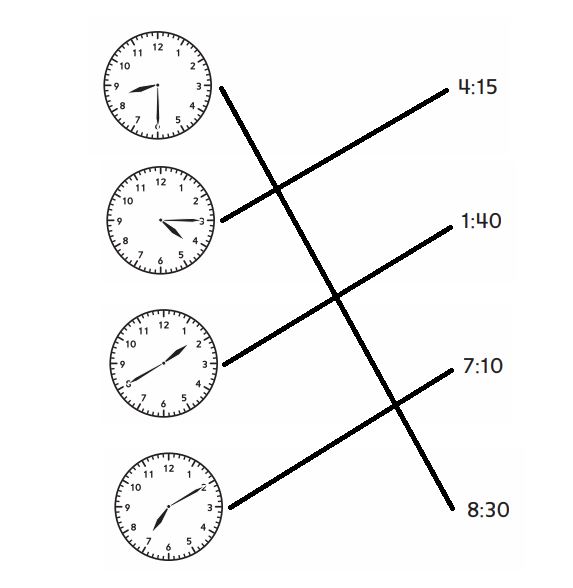
Practice
Question 5.
__ = 5 + 6
Answer:
11
Question 6.
12 – __ = 8
Answer:
4
Everyday Math Grade 2 Home Link 5.6 Answer Key
Adding and Subtracting 10 and 100
Family Note
Today we learned rules for adding and subtracting 10:
- To add 10, increase the tens digit of a number by 1: 24 + 10 = 34 772 + 10 = 782
- To subtract 10, decrease the tens digit of a number by 1: 98 – 10 = 88 615 – 10 = 605 When the number has a 9 in the tens place (for addition) or 0 in the tens place (for subtraction), the hundreds digit also changes:
- To add 10, increase the hundreds digit by 1 and change the tens digit to 0: 396 + 10 = 406
- To subtract 10, decrease the hundreds digit by 1 and change the tens digit to 9: 703 – 10 = 693 We also learned rules for adding and subtracting 100:
- To add 100, increase the hundreds digit of a number by 1: 643 + 100 = 743
- To subtract 100, decrease the hundreds digit of a number by 1: 451 – 100 = 351
These rules help children mentally add or subtract 10 or 100.
Please return this Home Link to school tomorrow.
Solve mentally. Tell someone at home about the rules you used.
Question 1.
62 + 10 = ___
Answer:
72
The rule used for this is: To add 10, increase the tens digit of a number by 1
Question 2.
58 – 10 = __
Answer:
48
The rule used for this: To subtract 10, decrease the tens digit of a number by 1
Question 3.
116 + 10 = __
Answer:
126
The rule used for this is: To add 10, increase the tens digit of a number by 1
Question 4.
__ = 391 – 10
Answer:
381
The rule used for this: To subtract 10, decrease the tens digit of a number by 1
Question 5.
__ = 786 + 100
Answer:
886
The rule used for this is: To add 10, increase the tens digit of a number by 1
Question 6.
625 – 100 = __
Answer:
525
The rule used for this: To subtract 10, decrease the tens digit of a number by 1.
Question 7.
Clare did 24 sit-ups. She rested and then did 10 more. How many sit-ups did she do in all? __ sit-ups.
Answer:
24+10 = 34
Therefore, Clare did 34 sit-ups
Question 8.
Freddie had 215 marbles. He gave 10 to a friend. How many does he have left? __ marbles
Answer:
215-10= 205
Freddie has 205 marbles
Practice
Question 9.
3 + __ = 12
Answer:
9
Question 10.
16 – 9 = __
Answer:
7
Question 11.
14 = __ + 8
Answer:
6
Question 12.
11 – __ = 8
Answer:
3
Everyday Math Grade 2 Home Link 5.7 Answer Key
Using Open Number Lines
Family Note
Today your child learned about open number lines. Children can use open number lines to quickly record their thinking when they use mental strategies to add or subtract.
Here is an example: To solve 29 + 36, think of 36 as three 10s and six 1s. Add the 10s first. Think,
“29 plus 10 is 39, plus 10 more is 49, plus 10 more is 59.”

Then add the 1s. Think, “If I add 1 more, I get to 60. Then I still have 5 to go; 60 plus 5 is 65.”

Open number lines are quick and easy to draw because they show only the numbers needed to solve a particular problem. For example, the open number line above only shows 29, 39, 49, 59, 60, and 65 because these are the stopping points used in the mental addition strategy described above.
Please return this Home Link to school tomorrow.
Solve. You may use the open number lines to help.
Question 1.
There are 32 beads on one necklace and 26 beads on another. How many beads in all? __ beads

Answer:
58
Explanation :

Question 2.
You have 16 apples in your basket. You pick 17 more. How many do you have now? __ apples

Answer:
33
Explanation :

Everyday Math Grade 2 Home Link 5.8 Answer Key
Change Number Stories
Family Note
Your child has learned how to represent a problem by using a change diagram, which is shown in the example below. Using diagrams like this can help children organize the information in a problem. When the information is organized, it is easier to decide which operation (+, -, ×, ÷) to use to solve the problem. Change diagrams are used to represent problems in which a starting quantity is
increased or decreased. For the number stories on this Home Link, the starting quantity is always increased.
Please return the second page of this Home Link to school tomorrow.
Do the following for each number story on the next page:
- Write the numbers you know in the change diagram.
- Write ? for the number you need to find.
- Write a number model. Use ? for the number you need to find.
- Answer the question.
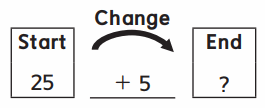
Example: Twenty-five children are riding on a bus. At the next stop,5 more children get on. How many children are on the bus now?
The number of children on the bus has increased by 5.
Possible number model: 25 + 5 = ?
Answer: There are now 30 children on the bus.
Everyday Math Grade 2 Home Link 5.9 Answer Key
Parts-and-Total Number Stories
Question 1.
You wear a backpack and carry a small suitcase. How many pounds do you carry in all?
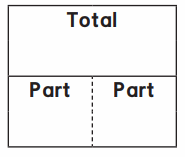
Number model:
Answer: __ pounds
Answer:
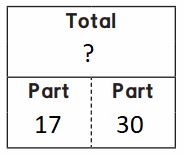
Number model: 17+30 =?
Answer = 47 pounds
Question 2.
You carry the large suitcase and the small suitcase. How many pounds do you carry in all?
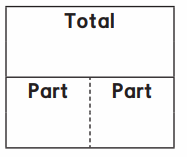
Number model:
Answer: __ pounds
Answer:
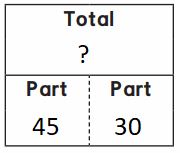
Number model: 45+30 =?
Answer = 75 pounds
Question 3.
You wear the backpack and carry the package. How many pounds do you carry in all?
Draw your own parts-and-total diagram:
Number model:
Answer: __ pounds
Answer:
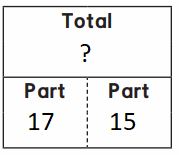
Number model: 17+15 =?
Answer = 32 pounds
Everyday Math Grade 2 Home Link 5.10 Answer Key
Temperature
Question 1.
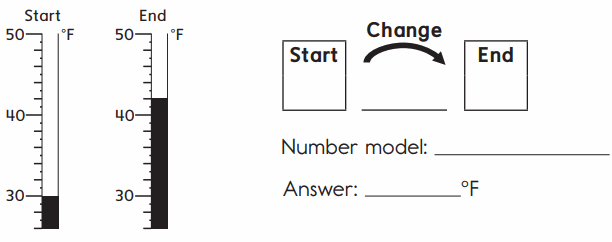
Answer:
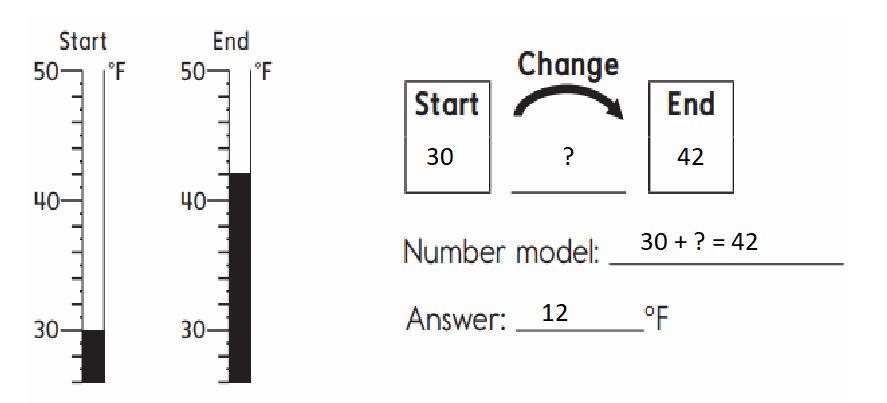
Question 2.
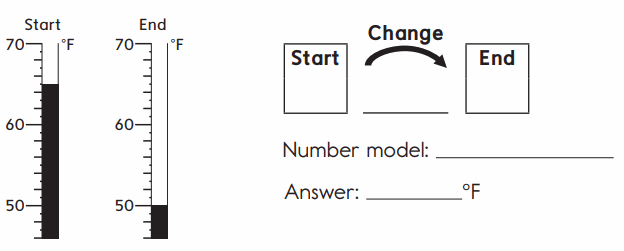
Answer:
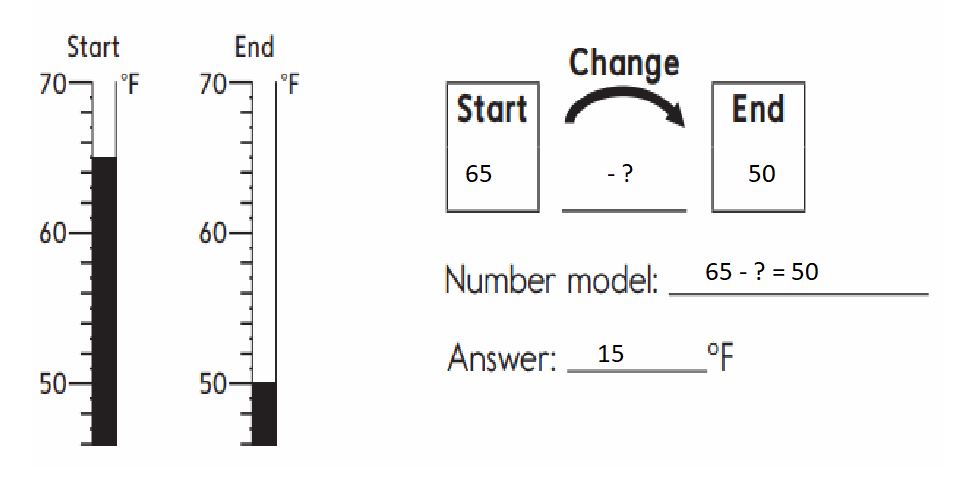
Question 3.
Explain how you found the answer to Problem 2.
Answer:
The initial temperature is 65
The final temperature is 50
So, I Counted from 50 to 65 and the answer is 15.
Everyday Math Grade 2 Home Link 5.11 Answer Key
Addition Strategies
Family Note
In this lesson we added multidigit numbers. Your child solved an addition number story using two different strategies. Being able to solve problems more than one way and with different tools can help children confirm their answers and choose methods that work well in certain situations. Adding multidigit numbers will be revisited throughout the year.
Please return this Home Link to school tomorrow.
Uma bought a telephone for $36 and blank CDs for $14. What was her total cost?
Question 1.
Show how to solve this problem using base-10 blocks.
Answer:
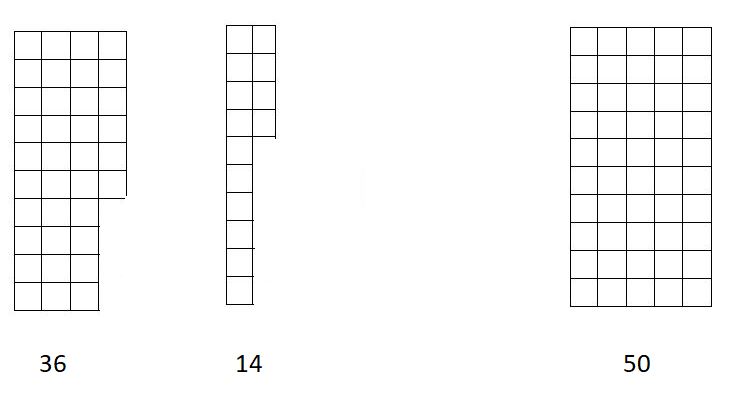
Question 2.
Show how to solve this problem using an open number line.

Answer:
Answer is 50.
